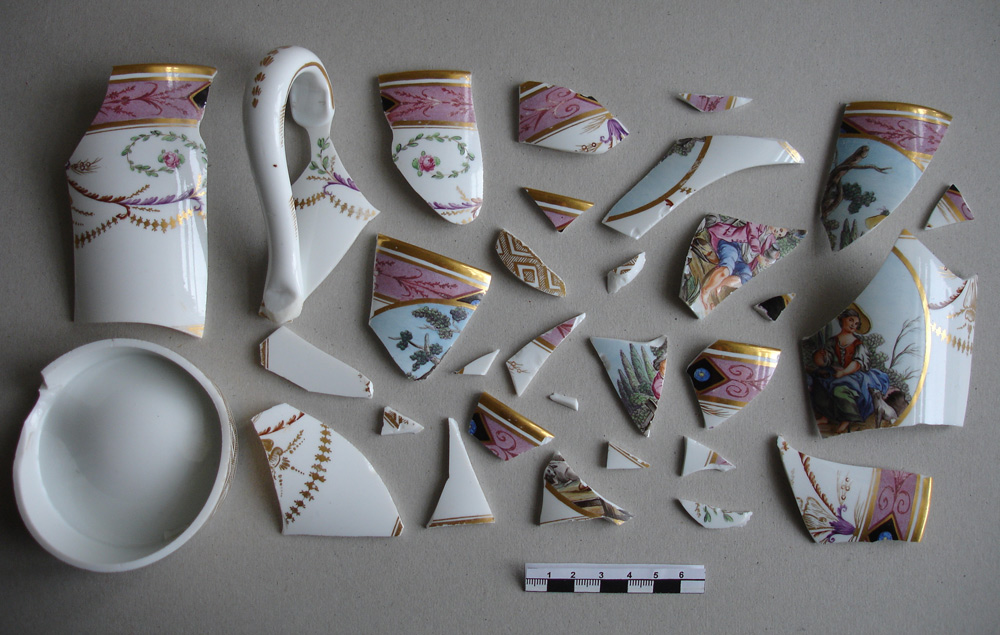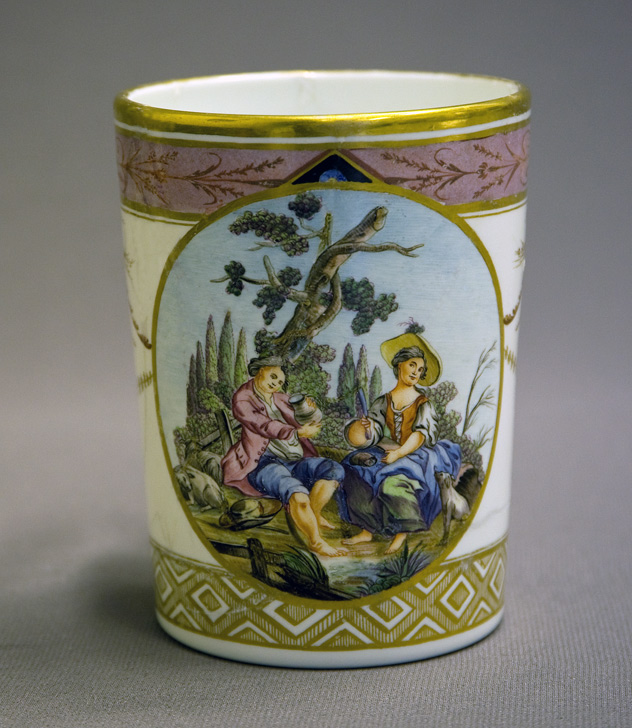 |
 |
|
Studio head
Maria Bessmertnaya
completing the color finishing of new replacement
fragments on an 18th-century ceramic sculpture, Grouse.
2015 |
|
Many of the glass and ceramic sculptures and tableware items in the
Russian Museum’s custody come from the Imperial (Lomonosov) Porcelain
Factory and pre-1917 Russia’s many private glass and porcelain
manufacturers -- Gardner, Batenin, Yusupov, Miklashevsky, Safronov,
Kornilov, and a few others, as well as the St. Petersburg Glass Works,
Bakhmetyev’s Cut-Glass Factory at Nikolsk, and Maltsev’s Glass Factory.
The Russian Museum’s collection of ceramics also includes a great
variety of Russian folk art styles, from Gzhel and Skopin painted
ceramics to Dymkovo and Filimonovo folk toys, as well as the local
ceramic art genres of other Russian provinces and modern ceramic
artworks created in various parts of Russia.
Applied artworks that the museum receives via its purchasing section all
too frequently show evidence of unprofessional conservation. Cracks,
corrosion, all kinds of soiling, broken pieces, missing fragments… This
is a much-shortened list of the more typical problems requiring the
attention of our conservation staff.
If you search the archives from long ago, you will not find a glass and
ceramics restoration studio in the Russian Museum’s Conservation
Department. Conservation tasks involving glass or ceramic items used to
be assigned to either the jewelry, silver, and timepiece studio or the
wood, furniture, and sculpture
studio. Some of the well-known restoration artists in those years were
Vladimir Klein (metal and jewelry), sculptor
Igor Krestovsky
(sculpture, wax, and ceramics),
Timofey Detz,
Konstantin Kavtaradze,
Nikolay Malashkin
(ceramics,
ivory, and
stone), Natalya Safronitskaya, and
Nikolay Chernyshov
(ceramics,
ivory, stone, and metal). They all held art degrees, but never trained
specifically in art conservation. They were
tireless searchers, inspired and guided by their creative experience,
their enthusiasm, and their love of art.
Studio head
Maria Bessmertnaya completing the color finishing of new
replacement fragments on an 18th-century ceramic sculpture, Grouse. 2015
The bulk of the Russian Museum’s applied art collection was evacuated to
Solikamsk after the Nazi invasion. The remaining pieces, packed in
boxes, stayed in the museum. There being no other specialists on hand
during the evacuation period, the applied arts department head Boris
Emme had to personally undertake the complex restoration of a mid-18th-century
imperial porcelain vase, gluing its 53 fragments together himself. Emme
also wrote a methodological manual on the storage and conservation of
ceramic items during the war years. Many of the points he makes in his
book are entirely in tune with contemporary, research-informed
principles of ceramic conservation.
 |
 |
 |
|
During restoration |
After
restoration |
|
Restoration of an 18th-century porcelain mug (No.
ST-319). The item had been shattered into 30 pieces and poorly
glued back together. The item was broken down again and traces
of the old glue were removed. It was then reassembled and glued
back together. The missing
parts were filled with conservation primer and tinted. The
restoration was done by
Raisa Starikova
and
Lyudmila Serebryakova.
2010 |
|
|
The ceramics conservation work of
Irina Dubovik
and
Sofya Kirsanova
made a real difference in the 1950s and 1960s.
Sculptors by education, there was hardly an applied, folk, or Old
Russian art style or material they could not tackle successfully,
including wood,
metal, glass, and ceramics. As there was more work than they could
handle on their own, colleagues from Moscow would often lend a helping
hand. These included glass and ceramics restorers A. Onkel, I. Yegorova,
A. Morozova and S. Annonskaya of the Grabar National Art Conservation
Studio (VKhNRTs) and I.
Khazanova of the All-Union Research Institute for Art Conservation (VNIIR).
A new section for the conservation of applied art and sculpture was set
up in 1970, and Svyatoslav Ivanov was appointed its first director.
Staff restoration artists
Raisa Starikova
and
Lidiya Andreyeva
worked under Ivanov’s stewardship. There existed, by that time, strong
collaborative ties between the Moscow-based art conservation and
research centers and the Russian Museum. The museum’s staff restorers
would travel to Moscow to take on internships, share expertise, and
attend workshops or conferences.
 |
|
Restoration artist
Nadezhda Govorkova completes
the reconstruction of the floral ornament on a ceramic wine
bucket. 2017 |
|
The search was on for new conservation materials, and the applied art
and sculpture team was quick to put them to work. One example was the
new gold-plating technique for finishing added parts, which included
gold leaf (glossy) and
shell gold (matte).The
team, in collaboration with the museum’s chemical lab, developed a
methodology to clean ingrained grime from ceramic items. A decade of the
team’s work resulted in the “Conservation Methodology for Ceramic Items
in the State Russian Museum” (written by
Raisa Starikova),
which was ratified by the Academic Board in 1981.
The glass and ceramic conservation studio currently
employs four restorers with excellent professional credentials. Their
job descriptions cover a vast scope of duties, including preventive
surveys of artworks, exhibit preparation (condition profiling, packing
-- often involving the creation of customized packaging for irregularly
shaped items, mounting
and dismantling exhibits), and keeping records and
photographic
documentation.
But their main job – restoration and conservation –incorporates a
great diversity of processes, from basic washing to gold-plating and
toning to mask replaced fragments. One of the nuances of this work is
that the materials the restorers use are completely different from those
used in the original artwork – ceramic mixtures and glass. When
replacing missing parts on an item, the
restorer aims to make the replacement material match the original
material as closely as possible, blending it seamlessly into the
artwork. Whether the replaced fragments are a perfect likeness of the
original is a secondary concern.
 |
 |
 |
|
Before restoration |
During restoration |
After restoration |
|
Restoration of the late 19th-century Rooster
jug
(No. FS-1553) sculpted by Aleksandr Golovin. The item came into
restorers’ hands with evidence of unprofessional gluing. It was
broken down into 95 fragments,
glued back together, and cleaned of grime. Missing bits were
replaced and toned up. The restoration was performed by
Maria Bessmertnaya
and
Nadezhda Kasatkina.
2012 |
|
|
Artwork reconstructed by the studio’s restorers has been exhibited at
dozens of fine porcelain and folk ceramics shows in recent decades. The
1994 exhibition Imperial Porcelain Vases and Dining Accessories from
the First Quarter of the 19th Century featured a
particularly large display of exhibits restored from a very bad state of
disrepair. Their restoration included disassembly, washing, cleaning off
old adhesive, de-rusting the
braces, occasionally
replacing the mounting fixtures, bonding, replacing missing fragments
with parts molded or cast from specially formulated compounds, and
toning the replacements with gold leaf, shell gold, or tempera. Inspired
by the growing exhibition activity and the many new exhibition ideas in
the past few years, both theme-focused and comprehensive in scope, the
museum has taken a fresh look at its backroom stocks, and has been able
to bring to light some excellent applied art that had been away from the
public eye for decades.
For the exhibition Romanticism in Russia, the studio restored two
early 19th-century uranium glass floor lamps decorated with
gold-plated bronze. The items were taken apart entirely, down to the
tiniest screw, cleaned, and glued back together. Missing parts were
replaced with glass of the same hue and the lamps
were reassembled. (The restoration was performed by
Lyudmila Serebryakova
and
Raisa Starikova).
In an equally challenging and rewarding conservation project, the
studio’s artists restored a mid-19th-century table from the
Imperial Porcelain Factory, the porcelain top of which consisted of 11
sections featuring interior views and picturesque landscapes. The item
was in very bad shape: its metal carcass was deformed, the fasteners
were gone, and porcelain parts of the legs were broken. The item was
fully disassembled, cleaned, and glued. The metal parts were de-rusted,
and missing metal parts and porcelain fragments were replaced. (The
restoration was performed by
Nadezhda Kasatkina
and
Aleksandr Melnikov.)
 |
|
Lead restorer
Nadezhda Kasatkina
replaces missing gold plating on a unique late
19th-century teapot. 2012 |
|
The glass and ceramics team also restored the Sadko platter, a
work of Mikhail Vrubel, for the 1995 The Russian Museum in Bonn
exhibition. This involved gluing on 13 large fragments, reinforcing them
on the backside, toning them, and providing the item with a custom-made
stationary fastening construction.
(The restoration was performed by
Lyudmila Serebryakova,
Nadezhda Kasatkina,
Raisa Starikova,
and
Aleksandr Melnikov.)
Two ceramic panels by
Viktor Borisov-Musatov, created for the Moscow
Tram Authority in 1904, were reconstructed for the exhibition
Symbolism in Russia. These panels, initially conserved in the 1950s,
had not been exhibited in more than 30 years. The large-size, irregular
fragments were glued together, then reinforced on the back. Missing
parts were reconstructed and the paintwork was redone based
on the artist’s sketches. A fastening structure was designed to make it
possible for the panels to go on display. (The restoration was performed
by
Nadezhda Kasatkina
and
Raisa Starikova.)
The relief Medusa by early 20th-century sculptor
Artemy Ober had been broken up into 28 fragments, and
some parts were missing. The item had undergone prior conservation.
Undoing the old bonding and clearing the seams proved a challenge, as
the adhesive mastic was found to be permanent and exceptionally
difficult to remove. Having tried in
vain all the known chemical cleaning methods, restorer
Lyudmila Serebryakova was left no other choice but to resort
to mechanical
cleaning. She therefore had to be extra careful so as not to damage the
surface of the item. With new bonding, missing parts replaced, and the
replacements properly toned, the relief was now ready to go on public
display.
The complex and versatile restoration processes used on glass and
ceramic artworks were showcased at exhibitions dedicated exclusively to
art conservation: the 1977 exhibition of the work of the State Russian
Museum’s Conservation Department, and the 1984 exhibition Art
Conservation in the USSR in Moscow and Leningrad.
|
|

